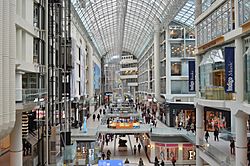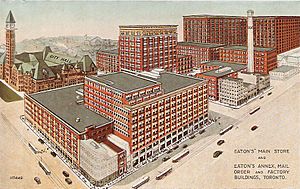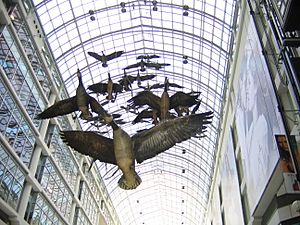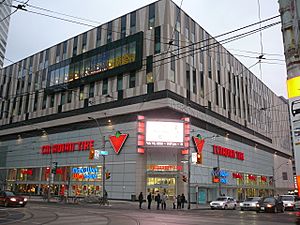Toronto Eaton Centre facts for kids

Looking south in the atrium (2013)
|
|
| Coordinates | 43°39′14″N 79°22′49″W / 43.65389°N 79.38028°W |
|---|---|
| Address | 220 Yonge Street Toronto, Ontario M5B 2H1 |
| Opening date | 1977 (first phase) |
| Developer | |
| Management | Cadillac Fairview |
| Owner | Cadillac Fairview |
| Architect | Eberhard Zeidler & B+H Architects |
| No. of stores and services | 235 |
| No. of anchor tenants | 6 |
| Total retail floor area | 201,320 square metres (2,167,000 sq ft) |
| No. of floors | 4 (mall arcade, including galleria), 10 (portion formerly occupied by Eaton's store), 8 (Hudson's Bay building), 36 (highest number of storeys of office component) |
| Parking | 2 parkades |
| Public transit access | |
The Toronto Eaton Centre is a huge shopping mall and office building complex in Downtown Toronto, Ontario, Canada. It is often called the Eaton Centre. This famous place is owned and managed by a company called Cadillac Fairview. It got its name from the Eaton's department store chain, which used to be a main store there. The Eaton's chain closed down in the late 1990s.
The Toronto Eaton Centre is one of the most visited places in Toronto. It is also North America's busiest shopping mall. Many people visit because it's easy to get to by public transport. Its location in downtown Toronto and lots of tourists also make it very popular. The mall has over 330 stores and restaurants. In 2015 alone, nearly 49 million people visited the Eaton Centre. This is more visitors than some of the busiest malls in the United States. It even had more visitors than Central Park in New York City that year.
Contents
Where is the Eaton Centre located?
The main part of the Toronto Eaton Centre is located between several streets. These are Yonge Street (east), Queen Street West (south), and Dundas Street West (north). To the west, it is bordered by James Street and Trinity Square. The main Hudson's Bay store is also part of the complex. It is connected by a special walkway over Queen Street West.
The inside paths of the Eaton Centre are part of Toronto's PATH system. This is an underground network for pedestrians. You can reach the centre using two subway stations: Dundas and Queen. Both are on Line 1 Yonge–University. The complex also includes four office buildings. These are at 20 Queen Street West, 250 Yonge Street, 1 Dundas Street West, and 401 Bay Street. The Ryerson University Ted Rogers School of Management is also here. A 17-storey Marriott hotel is also connected to the Eaton Centre.
History of the Eaton Centre
Early plans for the mall

Timothy Eaton started a dry goods store on Yonge Street in the 1800s. His store changed how people shopped in Canada. It grew into the biggest department store chain in the country. By the 1900s, the Eaton's chain owned most of the land where the Eaton Centre now stands. This land was bordered by Yonge, Queen, Bay, and Dundas streets. Two important buildings, Old City Hall and the Church of the Holy Trinity, were not owned by Eaton's.
The Eaton's land used to have Timothy Eaton's first store. Later, it had Eaton's large Main Store, the Eaton's Annex, and other buildings. In the 1960s, Eaton's started moving its warehouses to cheaper areas outside the city. They wanted to use their valuable downtown land better. They planned to build a huge new main store. This new store would replace their old Main Store and the Eaton's College Street store.
In the mid-1960s, Eaton's announced big plans. They wanted to build a huge office and shopping complex. This complex would cover several city blocks. Eaton's wanted to tear down Toronto's Old City Hall and the Church of the Holy Trinity. Many small city streets would also be closed. People in Toronto strongly disagreed about tearing down the city hall and church. Because of this, Eaton's stopped their plans in 1967.
The Eaton Centre plans started again in 1971. This time, Old City Hall would be saved. But the Church of the Holy Trinity still faced demolition. Its members fought hard to save it. In the end, the Eaton Centre plans were changed again. Both Old City Hall and the church were saved. The plans were even changed more to make sure the new complex would not block sunlight to the church.
These changes led to three big differences from the 1960s plan. First, the new Eaton's store moved north to Dundas Street. It was too big for its old spot on Queen Street. Second, the office part of the complex became smaller. It was no longer trying to expand the city's financial area. Finally, most of the centre moved closer to Yonge Street. It no longer had any front along Bay Street. So, Old City Hall and the church were saved. A nearby Salvation Army building was also saved for a while.
How the Eaton Centre got its name
When the centre opened in 1977, it was called "The Eaton Centre." In the early 1990s, its name changed to "Toronto Eaton Centre." This was to avoid confusion with other Eaton Centres in Canada.
The Eaton's department store chain went bankrupt in 1999. Even after this, the mall kept the Eaton Centre name. It was a way to honor Timothy Eaton and his first small shop. For a while, the mall used the name under a special agreement. But in 2016, Cadillac Fairview bought the rights to the Eaton's name.
In 2014, the mall's managers tried to make sure people used the full name, "Toronto Eaton Centre." But signs around the mall were not always consistent. Some just said "Eaton Centre." In September 2015, Cadillac Fairview announced a new plan. They would add "CF" to the front of all their mall names. So, the complex is now called "CF Toronto Eaton Centre" by its owners. New signs with this name were put up over the next year.
Building the Eaton Centre
Eaton's worked with the Cadillac Fairview company and the Toronto-Dominion Bank to build the Eaton Centre. The complex was designed by Eberhard Zeidler and Bregman + Hamann Architects. They created a multi-level mall with a vaulted glass ceiling. It was inspired by the Galleria Vittorio Emanuele II in Milan, Italy. At that time, the Eaton Centre's inside design was very new. It influenced how other shopping centers were built in North America.
The first part of the mall opened in 1977. This included the nine-storey Eaton's store. It was about 1,000,000 square feet (93,000 m2). The old Eaton's store was then torn down. The south part of the complex opened in its place in 1979. In the same year, the north end of the complex added a multiplex cinema. This cinema, called Cineplex, was the largest in the world at the time with 18 screens.
Some streets like Terauley Street and Louisa Street were closed. They disappeared from the city map to make room for the new complex. Albert Street and James Street were kept only around Old City Hall. The city of Toronto made sure people could still walk through the mall where Albert Street used to be. Trinity Square became a pedestrian-only area.
Many city planners did not like the outside design of the Eaton Centre at first. The complex faced inwards, with few stores or windows facing the street. This made the outside look less lively. A large parking garage took up much of the Yonge Street side. The city government also made the complex set back from Yonge Street. This was to allow for an extra lane on the street later. This made the centre even further from Yonge Street.
The office buildings in the complex were built over several years:
- "One Dundas West" (29 storeys) in 1977.
- "Cadillac Fairview Tower" (36 storeys) in 1982.
- "250 Yonge Street" (formerly Eaton Tower) (35 storeys) in 1992.
- "Simpson Tower" (33 storeys) at 401 Bay Street. This building was finished in 1969. It became part of the Eaton Centre in 2014.
Early years of the mall
The outside of the Eaton Centre store was designed in the style of the 1970s. It was meant to show Eaton's power and goals. Even with some disagreements, the centre was a huge success right away. It led to many other shopping centers across Canada using the Eaton name. The mall's profits were so good that they helped keep the struggling Eaton's chain going for another two decades. Eaton's finally went bankrupt in 1999. Today, the Eaton Centre is one of North America's best shopping places. It is also Toronto's most popular tourist spot.
One of the most famous sights in the mall is the group of fibreglass Canada geese. They hang from the ceiling. This sculpture is called Flight Stop. It was made by artist Michael Snow. There was also an important court case about it. One year, the mall managers put red ribbons on the geese for Christmas. They did not ask Michael Snow first. Snow sued, saying the ribbons made his artwork look "ridiculous." He felt it hurt his reputation as an artist. The court agreed with Snow. Even though the centre owned the sculpture, the ribbons had affected Snow's artistic rights. The court ordered the ribbons to be removed.

Changes in the 1990s and 2000s
When the Eaton's chain went bankrupt in 1999, Sears Canada bought many of its assets. This included the lease for the department store space at the north end of the mall. This gave Sears a great location in downtown Toronto. Sears Canada briefly ran the store as a fancy "eatons" mini-chain. But by 2002, it became a Sears store. Sears used the top four floors of its eight-story location for offices. The lowest floor became part of the mall. Even with these changes, the four-level Sears store was still the largest Sears in the world. After Sears bought Eaton's, the Timothy Eaton statue moved from the Dundas Street entrance to the Royal Ontario Museum.
In the early 2000s, the Eaton Centre's owners changed the mall's Yonge Street side. They moved it closer to the street. This made it look more like a city shopping area. Stores now opened directly onto the street. This created the feeling of a lively city street.
More changes in the late 1990s and early 2000s added new shopping space. The west side of the complex was expanded. The glass area at the corner of Yonge and Dundas streets was redesigned. Some old businesses, like a police office, moved out. This made room for H&M's main store in Canada.

One of the mall's two parking garages was torn down in 2003. This was the nine-storey Dundas Parkade. In its place, a new part of the Eaton Centre opened in 2006. This new section included Canadian Tire and Best Buy. Above these stores were Ryerson University's Faculty of Business and a new parking garage.
The retail part of the complex is about 1,722,000 square feet (160,000 m2). This makes it the second largest mall in Ontario.
Revitalization project in 2010
On June 18, 2010, Cadillac Fairview announced a big plan. They would spend $120 million to renovate the mall. This two-year project included new flooring throughout the mall. The two existing food courts would be updated. Washrooms would be improved and expanded. There would also be better lighting, new railings, and new entry doors. The project also focused on making the mall more environmentally friendly.
In June 2010, a video of a person shouting at the Eaton Centre doors became popular online. The mall was closing because of the 2010 G20 Toronto summit protests nearby. The video was later removed, but many people re-uploaded it.
The Eaton Centre since 2010
Urban Eatery food court
As part of the $120 million renovation, the Eaton Centre changed its food courts. The old food courts were replaced with one larger new food court in the north. This new food court, called the Urban Eatery, opened in September 2011. A larger Richtree Market restaurant opened at the south end in 2013. However, Richtree Market closed in March 2020.
The Urban Eatery has many different food options. It includes typical food court places and smaller Toronto-based restaurants. There are 900 seats in the Eatery, which covers over 45,000 square feet (4,200 m2). Some well-known restaurants there include KFC, McDonald's, Sbarro, Subway, and Tim Hortons.
The Urban Eatery tries to be eco-friendly. Most disposable packaging has been replaced with reusable dishes and cups. There are no regular garbage bins. Instead, people bring their food trays to special stations. Staff sort the items there. A machine turns most of the mall's food waste into pulp. This greatly reduces the amount of garbage.
Sport Chek, a Canadian sports store, is the only non-food store in the Urban Eatery.
Sears closure and new stores
On October 29, 2013, it was announced that Sears Canada would close its main store at the mall. On January 15, 2014, Nordstrom said it would take over some of the space Sears left. The lower level of the former Sears store was filled with various new shops. These opened in the fall of 2015. A three-floor Nordstrom store opened in the fall of 2016. Other stores like Uniqlo, a bigger H&M, and a Samsung Store also opened there.
In January 2014, Cadillac Fairview also announced something new. They would take over the ownership of the Hudson's Bay store across Queen Street. This Hudson's Bay store was already connected to the Eaton Centre by a walkway. It was renovated to share space with Saks Fifth Avenue. Free Wi-Fi became available throughout the Eaton Centre in late 2014. Before this, free Wi-Fi was only in bigger restaurants and some stores. To use the free Wi-Fi, you need a Facebook or Twitter account, or an email address.
A small part of the northern end of the Toronto Eaton Centre was used for a special shop. This was for the official 2015 Pan American Games in June and July 2015. It was also used during the 2015 Parapan American Games in August.

In 2017, the pedestrian bridge over Queen Street was rebuilt. This bridge connects the Eaton Centre and the Hudson's Bay store.
The Toronto Eaton Centre closed in June 2020. This was due to the COVID-19 pandemic and the George Floyd protests. It reopened in July 2020. One store above the Urban Eatery was changed into more food court space. This was to help with social distancing. However, this extra space closed again during the second wave of the pandemic.
Main stores at the Eaton Centre
| Name | No. of floors |
Year opened |
Year closed |
Notes |
|---|---|---|---|---|
| Best Buy | 1 | 2006 | N/A | |
| Canadian Tire | 2 | 2006 | N/A | |
| Eaton's | 9 | 1977 | 2002 | |
| H&M | 3 | 2004 | N/A | |
| Hudson's Bay | 8 | 1991 | N/A | Building acquired by Cadillac Fairview in 2014 |
| Nordstrom | 3 | 2016 | N/A | Replaced Sears |
| Saks Fifth Avenue | 4 | 2016 | N/A | Located within Hudson's Bay building |
| Sears | 4 | 2002 | 2014 | Replaced Eaton's |
Images for kids
See also
 In Spanish: Toronto Eaton Centre para niños
In Spanish: Toronto Eaton Centre para niños




